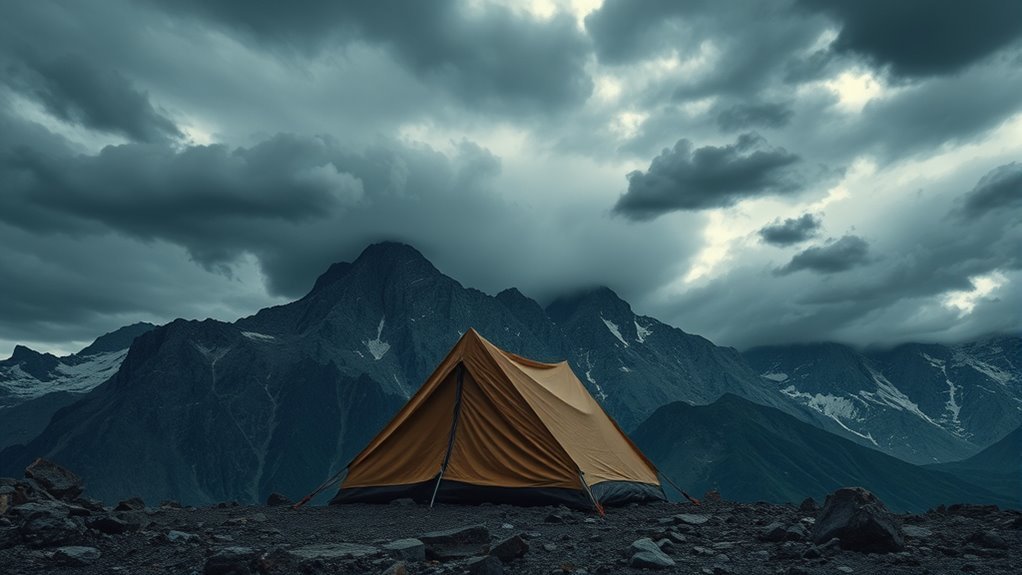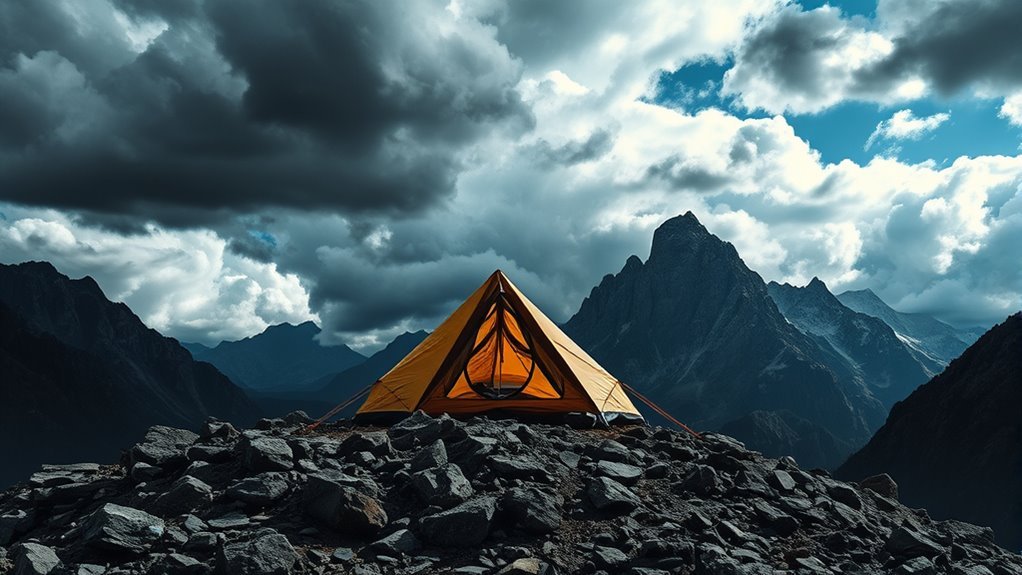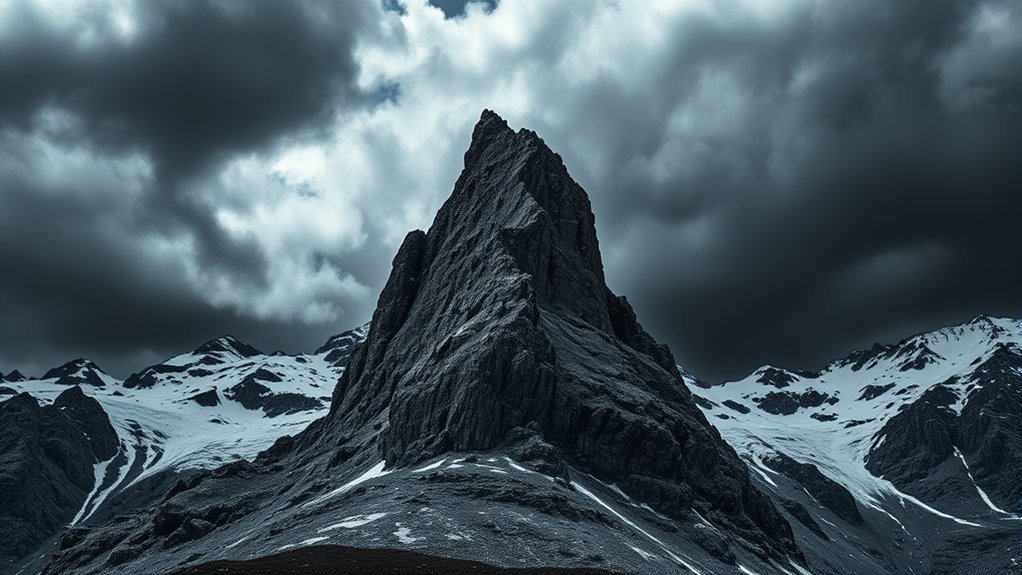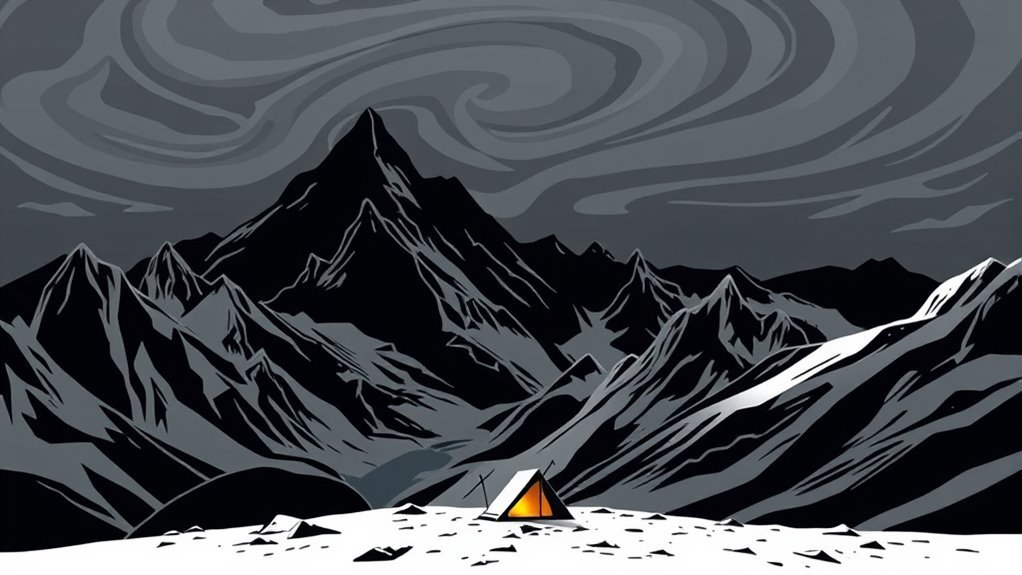Camping and hiking in squall-prone areas can be extremely risky due to the sudden intensity of squalls. These weather events bring rapid temperature drops, heavy rainfall, and strong winds, leading to dangerous conditions like flash floods. Navigation becomes challenging with reduced visibility and slippery terrain, increasing the risk of accidents. Proper gear and preparation are essential for safety. Awareness of weather patterns and emergency strategies can mitigate risks. Exploring more about these factors can improve outdoor safety.
Main Points
- Sudden squalls can cause rapid temperature drops, increasing the risk of hypothermia for campers and hikers.
- Intense wind gusts and heavy precipitation can lead to flash flooding, making trails hazardous and difficult to navigate.
- Reduced visibility during squalls can obscure landmarks, increasing the likelihood of getting lost or injured.
- Wet and slippery terrain heightens the risk of slips and falls, particularly on rocks and muddy paths.
- Unpredictable weather changes necessitate constant situational awareness and preparedness, complicating outdoor activities.
Understanding Squalls: Definition and Characteristics
Squalls are sudden, intense bursts of wind and precipitation that can greatly impact outdoor activities such as camping and hiking. These weather phenomena typically arise within larger storm systems, defined by rapid changes in atmospheric conditions.
Squalls can manifest as heavy rain, snow, or even hail, often accompanied by strong gusts of wind. They can develop quickly, sometimes without much warning, making them particularly hazardous for outdoor enthusiasts.
The duration of a squall is generally short, yet its intensity can lead to dangerous situations, such as flash flooding or falling branches. The temperature may drop considerably during a squall, creating a risk of hypothermia for those unprepared.
Understanding the traits of squalls is essential for outdoor adventurers, as recognizing their potential presence can aid in making informed decisions about safety and preparedness in the wilderness.
The Impact of Sudden Weather Changes on Outdoor Activities

Sudden weather changes can markedly disrupt outdoor activities, affecting both safety and enjoyment.
Understanding weather patterns and utilizing accurate predictions become vital for campers and hikers.
Proper safety precautions and appropriate gear are imperative to mitigate risks associated with unexpected conditions.
Weather Patterns and Predictions
As outdoor enthusiasts commence on hiking and camping adventures, they must remain vigilant about the ever-shifting weather patterns that can dramatically alter their plans.
Weather in squall-prone areas can change rapidly, often without warning, leading to dangerous conditions. Sudden temperature drops, unexpected rainfall, or severe wind gusts can transform a pleasant outing into a hazardous situation.
Predicting weather in these regions can be challenging, as local microclimates often defy broader forecasts. Accurate real-time updates are essential for outdoor adventurers, as reliance on outdated or generalized predictions can increase risks.
Understanding these unpredictable patterns allows hikers and campers to make informed decisions, ensuring they can traverse the outdoors safely and enjoyably, reducing the likelihood of being caught unprepared in severe weather.
Safety Precautions and Gear
When unpredictable weather conditions arise, outdoor enthusiasts must prioritize safety precautions and appropriate gear to mitigate risks.
These measures are essential for ensuring a safe and enjoyable experience in squall-prone areas. The right equipment can greatly reduce the dangers associated with sudden weather changes.
- Weather-Resistant Clothing: Layered, breathable, and waterproof attire to withstand rain and wind.
- Reliable Shelter: A sturdy tent designed to endure strong winds and heavy rain.
- Emergency Supplies: A well-stocked first aid kit, flashlight, and whistle for unforeseen situations.
- Weather Monitoring Instruments: Portable weather radios or apps to stay informed about changing conditions.
Increased Risk of Injury and Accidents
Camping and hiking often come with an increased risk of injury and accidents due to various factors.
Unpredictable weather patterns can create sudden changes that lead to hazardous conditions, while slippery terrain poses a constant threat to stability.
Additionally, limited visibility challenges can further complicate navigation and increase the likelihood of mishaps.
Unpredictable Weather Patterns
While outdoor enthusiasts often seek the thrill of nature, unpredictable weather patterns can greatly raise the risk of injury and accidents during hiking and camping trips. Sudden temperature changes, unexpected storms, and rapid shifts in wind can catch adventurers off guard. These elements can lead to hazardous conditions, increasing the likelihood of accidents.
- Lack of preparedness for extreme weather can lead to hypothermia or heat exhaustion.
- Flash floods can occur with little warning, endangering those in low-lying areas.
- Lightning strikes pose a considerable threat, especially in exposed locations.
- Visibility can diminish rapidly, making navigation difficult and increasing the risk of falls.
Awareness and preparedness are essential for minimizing risks associated with these unpredictable conditions.
Slippery Terrain Hazards
Although hikers and campers often relish the beauty of natural scenery, slippery terrain presents a considerable risk that can lead to injuries and accidents. Wet rocks, muddy trails, and damp foliage greatly increase the likelihood of slips and falls.
These hazards become even more pronounced during squall conditions, where sudden rain can transform a stable path into a treacherous one. Hikers may underestimate the danger, believing they can traverse challenging surfaces without incident.
Nevertheless, even experienced outdoor enthusiasts can misjudge their footing, resulting in sprains, fractures, or more severe injuries. Proper footwear, cautious movement, and awareness of the surroundings are essential to mitigate these risks.
Ultimately, the allure of nature must be balanced with the recognition of slippery terrain hazards.
Limited Visibility Challenges
Limited visibility can substantially heighten the risk of injury and accidents during hiking and camping activities. In squall-prone areas, sudden weather changes can obscure trails, making it difficult for outdoor enthusiasts to maneuver safely.
This lack of visibility can lead to disorientation, increasing the likelihood of falls or collisions with obstacles.
- Reduced ability to assess terrain conditions
- Difficulty in spotting potential hazards
- Increased chances of getting lost
- Challenges in communicating with fellow hikers
As a result, it is vital for individuals to be prepared for sudden changes in weather and to guarantee they have appropriate gear and knowledge to mitigate these risks.
Awareness and caution are essential for safety in these unpredictable environments.
Essential Gear and Preparation for Squall-Prone Areas

When venturing into squall-prone areas, proper gear and meticulous preparation are vital for guaranteeing safety and comfort. Adventurers should prioritize waterproof and windproof clothing, which can shield against sudden temperature drops and precipitation.
Layering is key; thermal base layers, insulating mid-layers, and durable outer shells provide both warmth and protection.
A reliable, high-quality tent designed for severe weather can safeguard against harsh winds and heavy rain. Additionally, sturdy footwear with good traction is essential for maneuvering slippery or unstable terrain.
Important tools include a first aid kit, a multi-tool, and a portable weather radio to stay informed of changing conditions.
Adequate food supplies and hydration systems must be included to maintain energy levels. Finally, carrying a headlamp or flashlight guarantees visibility during unexpected dark conditions.
Navigating Terrain Challenges During Severe Weather

Severe weather can greatly complicate navigation through various terrains, demanding heightened awareness and flexibility from outdoor enthusiasts. The unpredictable nature of squalls can alter scenery, making familiar routes treacherous. Consequently, individuals venturing into these areas must be prepared for the unexpected.
- Reduced Visibility: Heavy rain or fog can obscure trails and landmarks.
- Slippery Surfaces: Wet rocks and mud increase the risk of slips and falls.
- Flash Flooding: Sudden downpours may transform gentle streams into dangerous torrents.
- Landslides and Debris: Strong winds and rain can lead to falling trees and loose soil.
Navigators must remain vigilant, continuously evaluating their surroundings and modifying their routes.
Understanding local topography and weather patterns can be essential. In squall-prone areas, outdoor enthusiasts should prioritize safety by avoiding risky terrain and remaining alert to changing conditions.
Emergency Response Strategies for Squall Situations
Although squalls can arise suddenly and create hazardous conditions, having a well-defined emergency response strategy can greatly improve safety for outdoor enthusiasts.
First, individuals should identify safe shelter locations prior to starting on their trips. This includes knowing nearby buildings, caves, or dense forests that can provide protection from harsh winds and rain.
Second, a reliable communication tool, such as a satellite phone or a weather radio, is essential for receiving updates and contacting emergency services. Additionally, carrying a first aid kit and emergency supplies, such as food, water, and thermal blankets, can be lifesaving.
Finally, practicing situational awareness is vital; monitoring weather conditions and recognizing early signs of an approaching squall can promote timely action.
Making Informed Decisions: When to Cancel or Postpone Trips
Outdoor enthusiasts must acknowledge that there are times when safety dictates the need to cancel or postpone trips.
Weather conditions, particularly in squall-prone areas, can change rapidly, making it critical to assess the risks before commencing on an adventure.
Consider the following factors when making decisions:
- Severe Weather Alerts: Monitor forecasts for storms or squalls.
- Trail Conditions: Assess the trail's safety, especially after heavy rainfall.
- Personal Experience Level: Evaluate whether the group has the skills to handle potential hazards.
- Emergency Preparedness: Guarantee the group is equipped to respond to unexpected situations.
Common Questions
What Are the Best Locations for Camping in Squall-Prone Areas?
The best locations for camping in squall-prone areas often include coastal regions, mountainous terrains, and forested zones, where adventurers can experience dynamic weather while remaining vigilant and prepared for rapidly changing conditions.
How Can I Identify Early Signs of an Approaching Squall?
To identify early signs of an approaching squall, one should observe darkening skies, rapidly shifting winds, increased humidity, and distant thunder. Additionally, a drop in temperature can signal the imminent arrival of severe weather conditions.
What Are the Most Common Squall-Related Injuries?
The most common squall-related injuries include cuts and abrasions from flying debris, hypothermia due to sudden temperature drops, and trauma from falls or collisions caused by strong winds and reduced visibility. Awareness is essential for prevention.
Are There Specific Trails to Avoid During Squall Season?
Certain trails in squall-prone areas, particularly those with exposed ridges or steep drop-offs, should be avoided during squall season. These trails increase the risk of injury due to sudden weather changes and challenging terrain.
How Does Altitude Affect Squall Intensity in Mountainous Regions?
Altitude markedly influences squall intensity in mountainous regions. Higher elevations often experience more severe weather phenomena, as cooler temperatures and orographic lifting can improve precipitation, leading to stronger winds and increased storm activity in these areas.

